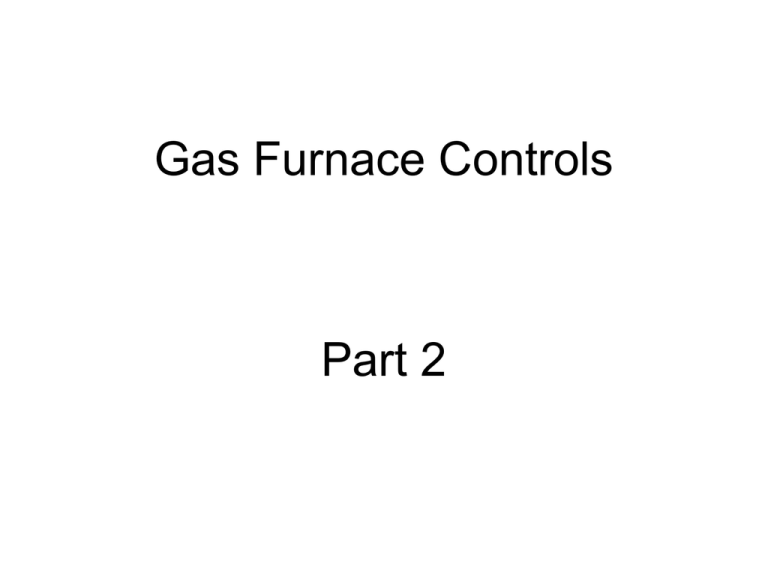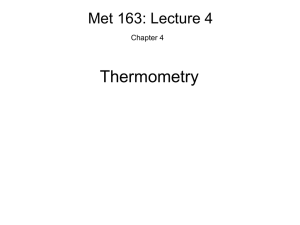File
advertisement

Gas Furnace Controls Part 2 Gas furnace controls – part 1 reviewed Group I of the four groups of controls systems. Part 2 will review Group II. The next slide will show all four groups as a review. Please refer to page A1 in your Student Handout Packet The four groups are as follows: I. Manual Ignition with Standing Pilot and Pilot Heat Switch II. Manual Ignition with Standing Pilot and Thermocouple III. Automatic Ignition with Standing Pilot IV. Pilotless Ignition Systems We will now look at the details of group II. II. Manual Ignition with Standing Pilot and Thermocouple Manual Ignition Manual Ignition means the pilot gas must be lit, generally with a match. Standing Pilot Standing Pilot means the pilot is always lit and available to light the main burners. Thermocouple The thermocouple is the safety device which proves the pilot is lit and available to light the main burners. Here is an example of a thermocouple. This group will have either: A. Main burner shut-off Only or B. Complete shut-off (100%) Main Burner Shut-off Only Main Burner Shut-off Only means that if the pilot should go out for any reason, the pilot gas will continue to flow, but the main burners will not be able to light. This will prevent the combustion chamber from filling up with raw (unburned) gas. Complete Shut-off (100%) Complete shut-off means that if the pilot should go out for any reason, the gas valve will not allow any gas to flow either to the main burners or to the pilot burner, thus 100%. Here is an example of a ‘Complete Shut-off (100%).’ This application is identified because there are three positions on this valve: OFF, PILOT and ON. Here is an example of a ‘Complete Shut-off (100%).’ This ‘knob’ requires one to manually turn it. Here is another example of a ‘Complete Shut-off (100%).’ PILOT ON Tip of knob indicates position OFF Knob to turn Before we go any further with the valves, we need to back up and consider the thermocouple. Thermocouple The thermocouple is a device which converts ‘heat’ to electricity. The voltage is so small that it is referred to as mv(millivolt). Thermocouple use on furnaces is a thing of the past, but there are many furnaces still operating that use the thermocouple as the ‘flame proving device.’ Thermocouple Even though the thermocouple is not being used on today’s furnaces, the concept of changing heat to electricity is sometimes applied when we use our temperature testers that use probes. Thermocouple The thermocouple as it is applied to furnaces to detect the pilot flame is composed of two different metals. Refer to your textbook for more information on the metals used. Thermocouple The thermocouple, when heated on one end by a flame, will have a ‘hot junction.’ The other end of the thermocouple, which is not heated by a flame, is the ‘cold junction.’ When the ‘hot junction’ is hot and the ‘cold junction’ is cold, the result will be the generation of a DC voltage. Thermocouple The DC voltage is then used by either a Baso switch or a solenoid valve to allow gas to flow to the pilot when voltage is present or close gas off to the pilot if there is no voltage present, thereby ‘proving’ that there is a flame or no flame. Thermocouple Refer to your textbook for the value of the DC voltages as well as the two conditions the thermocouple will be producing voltage: load or no load conditions. Thermocouple The thermocouple shown in the next slide is published as producing a voltage of 25 – 30 mv under no load conditions. No flame on base – COLD JUNCTION Flame makes contact on 3/8 – 1/2 inch of the tip – HOT JUNCTION Connection to a BASO switch or gas valve. Thermocouple The next slide will show a thermocouple that is NOT part of this control system, but was used previous to this control system. It is known as a Powerpile, because it was 25 thermocouples in series. It was also known as a ‘matchbook’ because it looks like a book of matches. produced 750 mv under no load conditions. It A ribbon of flame makes contact with the thermocouple(s) along the top so this becomes the HOT JUNCTION. Pilot gas enters here. We will now move onto the two devices that will use the thermocouple millivolts. 1. Baso Switch 2. CGC Valve Baso Switch A baso switch is a relay. It has three parts, just like any relay. It has a coil, contacts and mechanical linkage. Example of Baso Switch Cover Removed Another example of a Baso Switch Cover Removed Another example of a Baso Switch Front Baso Switch A baso switch coil is designed to become energized when millivolts is applied to it. Since the millivolts are so low, the relay mechanical linkage will not automatically work, so we have to move the lever to close the contacts and they will remain closed so long as millivolts are applied to the coil. Lever Plunger moves pin up into solenoid Push that direction Thermocouple connection Mechanical linkage moves button to close switch CGC Valve CGC is short for ‘combination gas control’ valve. But what is it a combination of? Many years ago there were three devices on a gas furnace piping system: pilot valve, main valve and regulator. The CGC valve combines all three into one housing. The Original Pilot Valve Main manual shut-off valve Regulator Main Valve Gas flow, as shown here, was from left to right. The ‘Pilot Valve’ was before the main valve, so if pilot went out, pilot gas continued to flow. The ‘Pilot Valve’ was known as the ‘B’ valve, for obvious reasons. These two valves are made of brass. They are tapered and are considered to be self sealing, although there is a gas valve grease that can be used if they do not seal. CGC Valve The CGC valve design uses the millivolts from the thermocouple to control a ‘solenoid’ valve within the valve body. It controls the ‘pilot portion’ of the valve. CGC Valve When millivolts are present, the pilot solenoid is open and gas flows through the pilot port to the pilot assembly and to the main valve port. When millivolts are not present, the pilot solenoid closes its port and does not allow any gas to flow to either the pilot assembly or main valve, thus the name: complete shut-off, also known as 100%. Example of a CGC valve. Connection for tube going to pilot assembly Gas Flow Example of a CGC valve. Mechanism/button used to manually push-in the pilot solenoid plunger. Example of a CGC valve. Thermocouple connection to pilot solenoid. Pilot solenoid inside housing at this location. Pilot Soleniod electromagnet Shaft which is pulled to the electromagnet when energized. Rubber flapper which opens and closes the pilot port in the CGC. Another example of a CGC valve. No separate mechanism used to manually push-in the pilot solenoid plunger. Here it is part of the valve knob assembly. Thermocouple connection to pilot solenoid. Sequence of Operation for this Group. 1. Turn gas CGC knob to the PILOT position. 2. DEPRESS either the knob or button so that you manually open the pilot solenoid valve port. Gas flow to pilot assembly. 3. Manually light the pilot and hold know for 60 seconds for thermocouple tip to get hot – hot junction. Sequence of Operation for this Group. 4. Release knob or button and pilot will stay lit because the millivolts are present to energize the pilot solenoid and keep the port open. 5. Turn CGC gas knob to ON position and the port to the main burners is now open, so that when the thermostat calls for heat, the main valve will be energized and will open and allow gas to flow to the main burners. This concludes the information relating to ‘Group II.’ Refer to your textbook for additional information. Miscellaneous Information (for tests) When troubleshooting, what are the three circuits a technician might have to troubleshoot? 1. Power 2. Control 3. Safety What are the first three things you do when you arrive on the job? 1. ASK the customer what they observed. 2. Check that the system switch on the thermostat is properly set. 3. Set the thermostat to call for MAXIMUM heat. Continue onto the next power point presentation in this series. Look for the title: Gas Furnace Controls – Part 3










